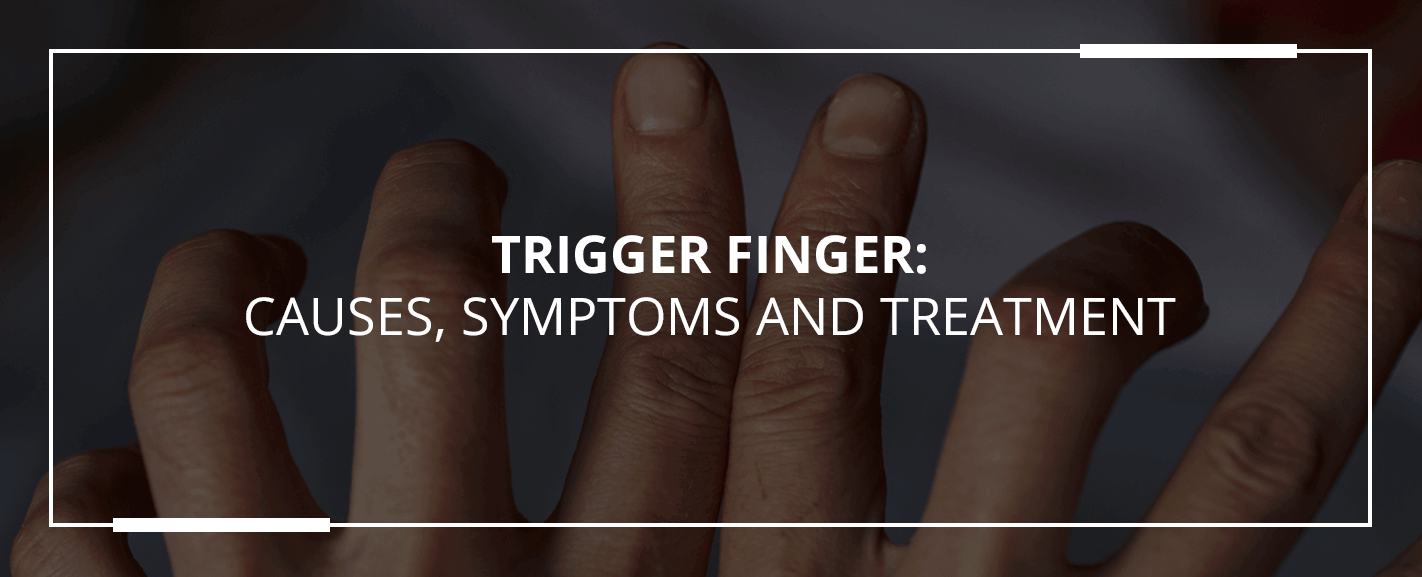
Do your fingers lock up when you’re holding something or working with your hands? You may be experiencing trigger finger, a painful condition that makes it hard to move or use your fingers.
Many people experience trigger finger, and it’s the fourth most common reason doctors refer patients to hand surgery clinics. The general population has a 2.6% risk of developing this condition, and some individuals are more prone to trigger finger than others.
If you’re suffering from the pain and discomfort of trigger finger, know that several treatment options are available, and most of them are non-surgical. In this post, we’ll explain possible trigger finger causes and cures and how to heal the condition on your own. If you can’t seem to get rid of trigger finger no matter what you try, we’re here to help you at OrthoBethesda.
What Is Trigger Finger?
Trigger finger happens when your finger or thumb gets stuck in a bent position. The bent finger may suddenly straighten with a pop — similar to pulling and releasing a trigger. This condition is also known as stenosing tenosynovitis.
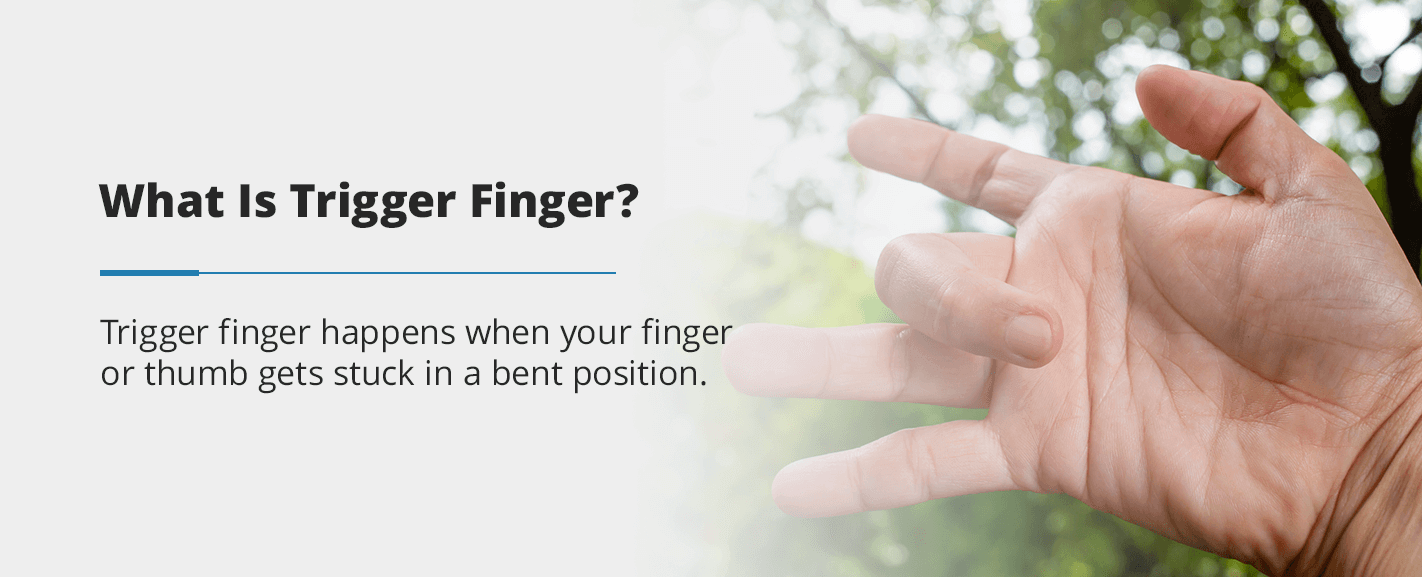
Trigger finger results from tendon inflammation. To envision how this condition occurs, think of the tendons in your hand. Your tendons are cords made of tissue, and they connect to your muscles and bones to help with movement. A thin layer of tissue covers every tendon to provide lubrication and protect against movement-related tissue damage. You might think of a tendon sheath as a tunnel.
Overuse or injury can cause tendon sheaths to become swollen and irritated. When this happens, your hand tendons can’t glide through the sheaths easily as they usually would. This issue causes your finger tendon to get stuck in its sheath, producing trigger finger symptoms. If tendon sheaths continue to become irritated, they can eventually cause scarring in the tendon or the formation of bumps. These factors can make trigger finger even worse.
Which Finger Is the Trigger Finger?
Trigger finger usually affects the ring finger or thumb, though it can occur in any digit or several fingers at once. Trigger finger also typically occurs in your dominant hand, but it can affect both hands.
What Are the Symptoms of Trigger Finger?
If you’ve recently developed trigger finger, you might first feel painless clicking when you move the affected finger. As the condition progresses, you may experience pain at the base of the affected finger when it moves or if you press on it. For example, you might notice that your index finger hurts from knitting or engaging in another hobby. Trigger finger pain and stiffness often appear in the morning, while firmly holding an object or while extending the affected finger.
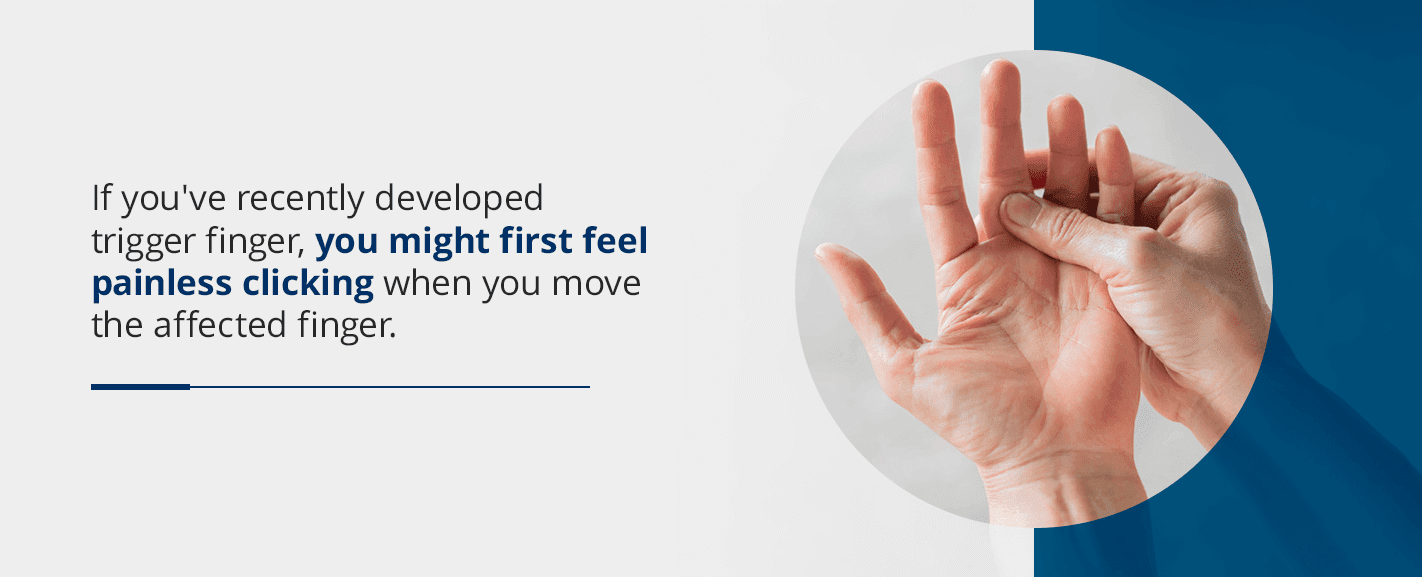
If trigger finger gets worse, the affected finger may stick when you bend it and then suddenly snap into a straight position. As the condition progresses, you may not be able to fully bend or straighten the affected finger.
Overall, common symptoms of trigger finger include:
- Pain in the palm at the base of the finger
- Finger stiffness, especially in the morning
- A popping or clicking sensation when moving the affected finger
- A lump around the base of your finger near the palm
- Finger locking into a bent position and then popping straight
- Finger unable to straighten from a locked position
What Causes Trigger Finger?
Doctors aren’t entirely sure what causes the tendon or sheath inflammation that may lead to trigger finger. However, several conditions and risk factors may increase your chance of experiencing trigger finger, including these medical conditions.
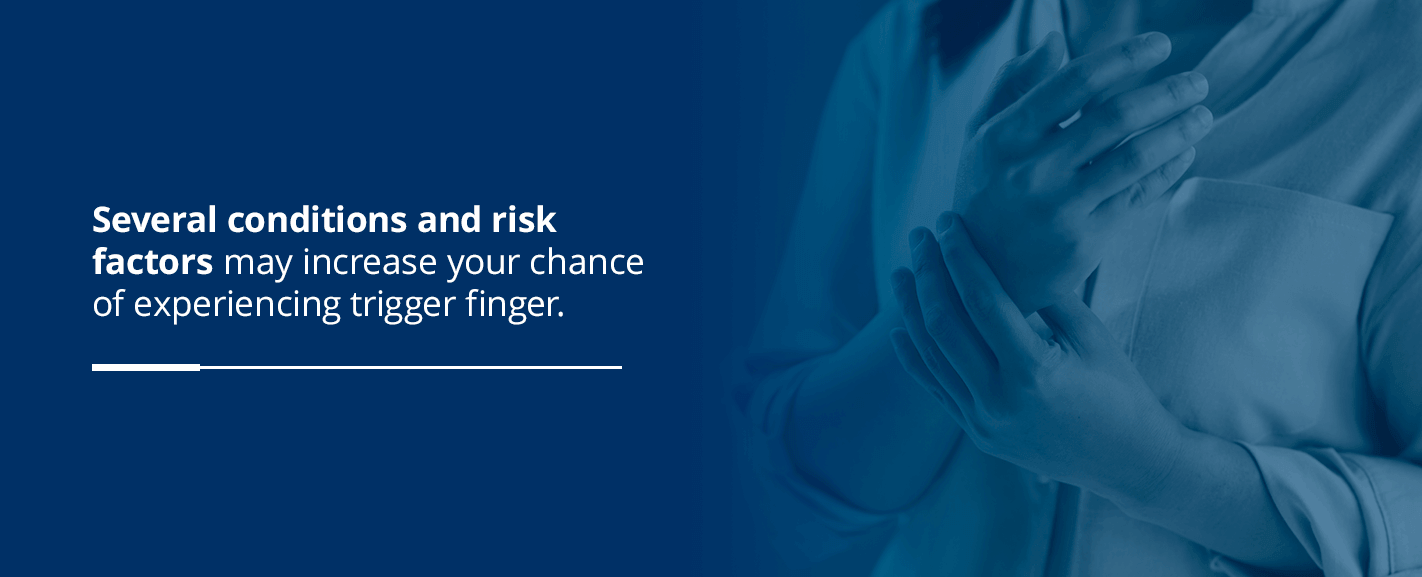
- Diabetes: According to an article published in the journal Plastic and Reconstructive Surgery, the risk of developing trigger finger is about five to 10 times higher for people with diabetes than the general population, and 25% of patients with trigger finger have diabetes. Also, approximately half of patients with diabetes with trigger finger will experience the condition in multiple fingers.
- Rheumatoid arthritis: Rheumatoid arthritis is an inflammatory disorder that can affect the joints, muscles and tendons in your hands. Since rheumatoid arthritis can cause inflammation of the tendons in your hands, it can lead to trigger finger.
- Gout: Gout is a painful type of arthritis resulting from uric acid buildup in the body. Gout commonly occurs in finger joints, and when left untreated, can damage the tendons. People with gout are more likely to experience trigger finger than the general population.
- Osteoarthritis: Osteoarthritis is one of the most common types of arthritis in the hands. Osteoarthritis causes cartilage deterioration in joints and eventually tendon-related pain. Trigger finger is more common with osteoarthritis.
- Dupuytren’s contracture: According to a study published in 2019, patients with trigger finger may be at increased risk of developing Dupuytren’s contracture and vice versa. Dupuytren’s contracture is a hand deformity that often develops over time. The condition affects the layers of tissue under the skin, eventually creating a thick cord that can pull the fingers into a bent position.
Other conditions that may cause inflammation in the hands and lead to trigger finger include kidney disease and hypothyroidism.
Trigger Finger Risk Factors
Trigger finger often occurs as a result of repetitive motion and overuse. For example, people are more likely to get trigger finger if their jobs require them to forcefully and repeatedly grasp tools. In general, here are some risk factors for the condition.
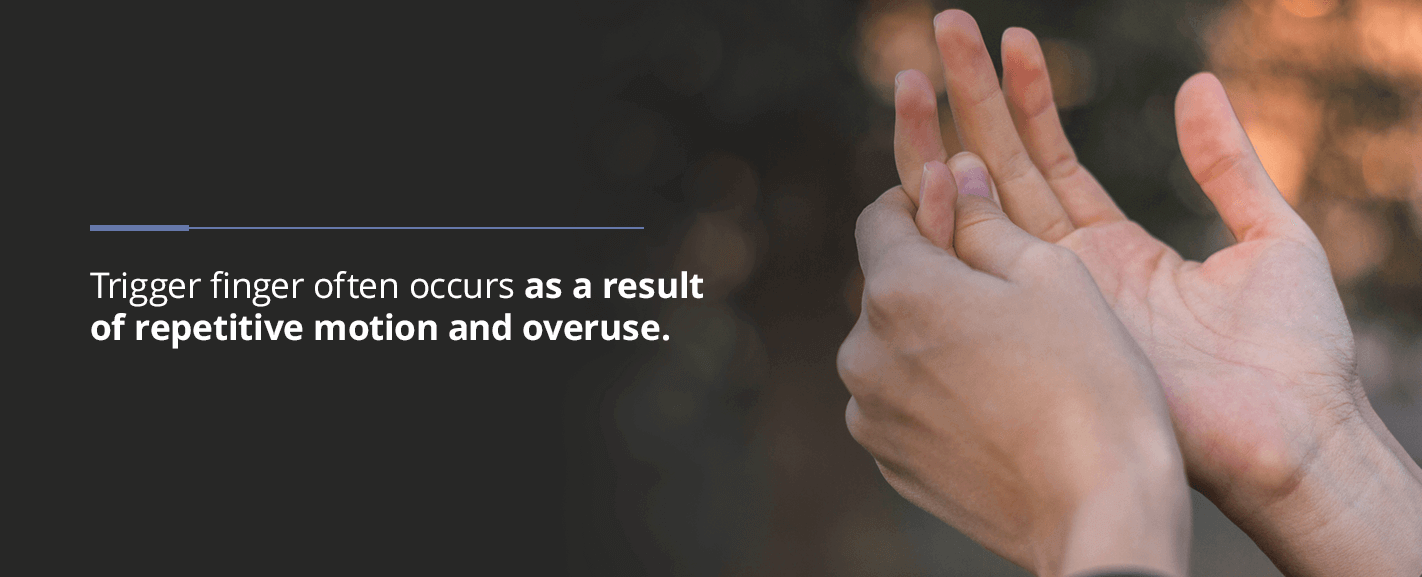
- Age: Trigger finger is more common in people over 40, suggesting that aging may play a role in developing this condition. Trigger finger symptoms often begin at age 58 on average.
- Sex: Women are two to six times more at risk of developing trigger finger than men for reasons unknown. However, women are also more likely to develop osteoarthritis and rheumatoid arthritis, so they are more susceptible to trigger finger.
- Hobbies: Some hobbies require repetitive movements or firm grasping, such as gardening, knitting and jewelry-making. These activities may increase the risk of developing trigger finger.
- Occupation: Trigger finger is prevalent among people who have jobs requiring repetition, frequent gripping or forceful finger or thumb movements. For example, farmers, musicians or industrial workers may be more prone to trigger finger.
What Is the Best Way to Treat Trigger Finger?
The best way to treat trigger finger is to try non-invasive options first. Essentially, you’ll want to care for trigger finger as you would sore muscles — with rest and over-the-counter pain medications. Specific exercises and wearing a splint can also help heal and prevent trigger finger in mild cases. If these methods don’t help, and if your symptoms continue to cause you pain or discomfort, speak to your doctor about other trigger finger treatments.
Here’s how to heal trigger finger without surgery.
1. Rest
If you have trigger finger due to overusing your fingers at work or home, you may find relief by resting your hand. Try to avoid activities that require repetitive gripping or the extended use of handheld vibrating tools for three to four weeks or until your symptoms improve. If you’re not able to rest your hands completely, consider wearing padded gloves as you work, which may help prevent strain.
2. Take Nonsteroidal Anti-Inflammatory Medications
Nonsteroidal anti-inflammatory drugs (NSAIDs) such as aspirin, ibuprofen or naproxen can help relieve pain and inflammation relating to trigger finger. If you have any concerns or questions about treating trigger finger with NSAIDs, speak with your doctor or pharmacist.
3. Apply Ice
Cold treatment can decrease pain and swelling by reducing blood flow to the affected area, but it’s essential to use this method in moderation — too much cold can cause stiff, sore joints. To apply ice or a frozen gel pack, first wrap the cold object in a piece of fabric, such as a thin towel. Next, apply the wrapped ice to the affected finger and palm for 15 minutes. Aim to use the ice pack every hour or two over the next three days or until the swelling subsides. Always wait until your skin returns to a normal temperature before reapplying the ice pack.
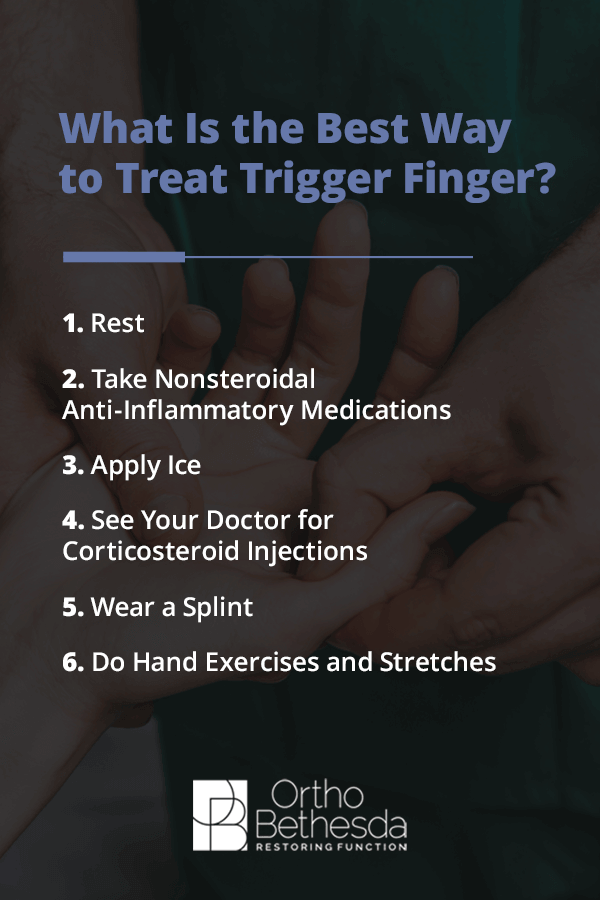
4. See Your Doctor for Corticosteroid Injections
If your symptoms do not improve with rest, anti-inflammatory medications or ice application, your doctor might recommend corticosteroid injections. You might also consider corticosteroid treatment if you’re experiencing severe trigger finger symptoms.
Corticosteroids are synthetic drugs similar to your body’s hormones that suppress inflammation. Doctors often prescribe them to treat inflammatory conditions, such as rheumatoid arthritis and allergies. Some corticosteroids can relieve trigger finger symptoms in 83% of patients.
During this procedure, the doctor will inject the corticosteroid into the tendon sheath at the base of the affected thumb or finger with a small needle. Corticosteroid shots typically contain a local anesthetic to numb the area, but you may feel a little pressure when receiving the injection.
Corticosteroid injections are usually effective for a year or longer. However, this type of trigger finger treatment may be less successful in patients with diabetes. Overall, this is a quick, straightforward procedure that may help you avoid surgery.
5. Wear a Splint
You can try wearing a splint on the affected finger to help the tendon rest. Consider wearing the splint at night, keeping your finger in an extended position, for up to six weeks.
6. Do Hand Exercises and Stretches
Gentle exercises and stretches can help improve movement in the affected finger, reduce stiffness and increase strength. If you can, spend 10 to 15 minutes a day doing finger and hand exercise. If it’s too challenging at first, that’s OK – your strength and flexibility will increase over time. Here’s an activity you can try to stretch the affected finger or thumb:
- Lay your hand flat on a table.
- Using your other hand, grab the affected finger and slowly pull it toward you while keeping the rest of your fingers flat.
- Lift the finger as high as you can without causing pain.
- Hold the finger in its “up” position for a couple of seconds and release.
- Complete one set of five repetitions.
- Repeat this exercise three times throughout the day.
How Do You Fix Trigger Finger Naturally?
With trigger finger, the affected finger often locks up in the morning and then releases as the day goes on. However, patients experiencing a severe case of trigger finger might find that their digit does not naturally come out of a bent position. When this happens, the person may have to use their other hand to straighten the affected finger. Rather than forcing the finger to loosen with your other hand, you may be able to release the locked finger by massaging its base. Here’s how to unlock trigger finger naturally and gently:
- Rub the base of the affected finger in a circular motion, gently applying pressure.
- Massage the area for a few minutes.
- Consider massaging the entire area connected to the affected finger, such as your hand, wrist and forearm.
If your finger continues to stay stuck no matter what you try or causes pain, call your doctor to ask about the best treatment for your needs.
Does Squeezing a Ball Help Trigger Finger?
Yes, squeezing a ball is a simple way to help relieve and prevent trigger finger. Using a small ball, try this exercise:
- Place the ball in the middle of your palm.
- Squeeze the ball tightly for a few seconds.
- Release the ball, opening your fingers wide.
- Repeat the exercise several times.
Can Trigger Finger Heal Itself?
Depending on its severity, trigger finger can heal itself and go away within a few weeks. If you continue to experience symptoms after about a month of rest or using a splint, consider speaking to your doctor about corticosteroid injections or other treatment options.
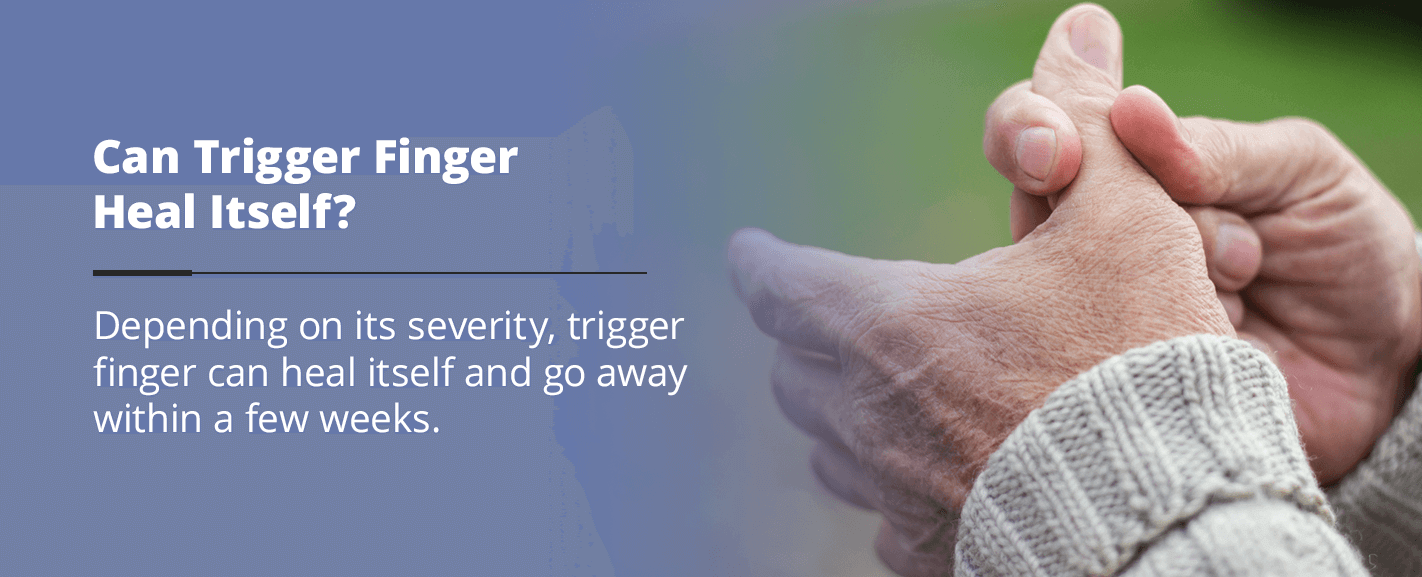
Can You Get Trigger Finger Twice in the Same Finger?
Yes, you can get trigger finger again in the same finger after it heals the first time. You can also experience this condition in other fingers on the same hand or your other hand. If trigger finger keeps coming back, you might consider surgery. After surgery, it’s rare for trigger finger to recur in the same finger.
What Happens With Untreated Trigger Finger?
Trigger finger isn’t usually anything serious, but it can cause pain and limited mobility and be a major nuisance. Trigger finger can also get worse over time if left untreated, and it may become permanently stuck in a bent or straight position. If your finger stays locked, your doctor may recommend surgery.
When Should You Get Trigger Finger Surgery?
Surgery is usually the last resort for trigger finger and something your doctor may recommend if other treatment options don’t work. Your doctor may also suggest surgery in the following circumstances:
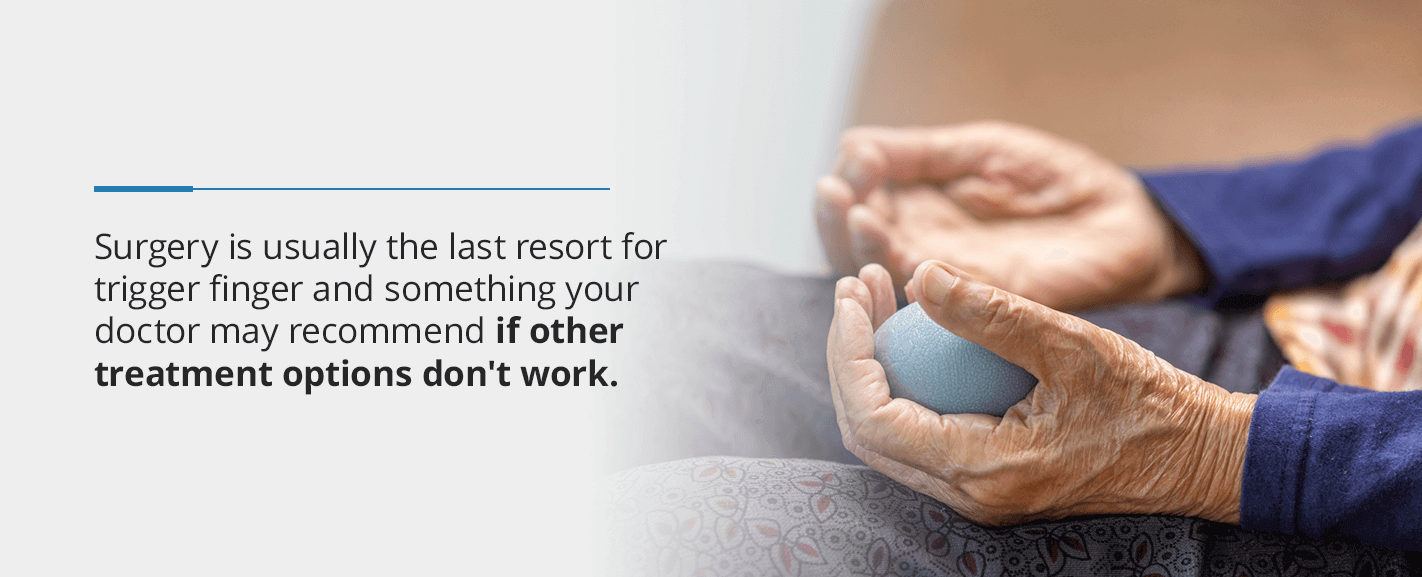
- You have diabetes.
- You’ve received corticosteroid injections, but they haven’t helped.
- You’re experiencing severe symptoms such as restricted movement and the inability to complete daily activities without pain.
- You feel embarrassed or anxious about trigger finger symptoms.
- Your symptoms are worsening.
What Is Trigger Finger Surgery?
Trigger finger surgery is a practical, quick way to treat the condition and does not require a hospital stay. There are two main types of surgery for trigger finger.
- Open release surgery: With open release surgery, the surgeon makes a small incision in the palm of your hand and carefully cuts through the tendon sheath to widen it and allow the tendon to glide smoothly. The surgeon will then close the wound with stitches. Open release surgery for trigger finger is the “gold standard” and has a success rate of 99%.
- Percutaneous release surgery: Percutaneous release surgery is a little less invasive than the open approach. With this method, the surgeon will insert a needle into the affected finger’s base rather than make an incision. The doctor will use the tip of the needle to break apart the tissue around the constricted tendon. According to a study published in the Journal of the Chinese Medical Association, the percutaneous release method has significantly better short-term patient satisfaction results. However, the study found that open release surgery leads to better long-term happiness.
Overall, both types of surgeries have proven effective in resolving trigger finger symptoms.
Is Trigger Finger Surgery Painful?
Whether you have open or percutaneous release surgery, the surgeon will first numb your hand with a local anesthetic to keep you from feeling pain during the procedure. You may also receive a sedative beforehand to help you relax.
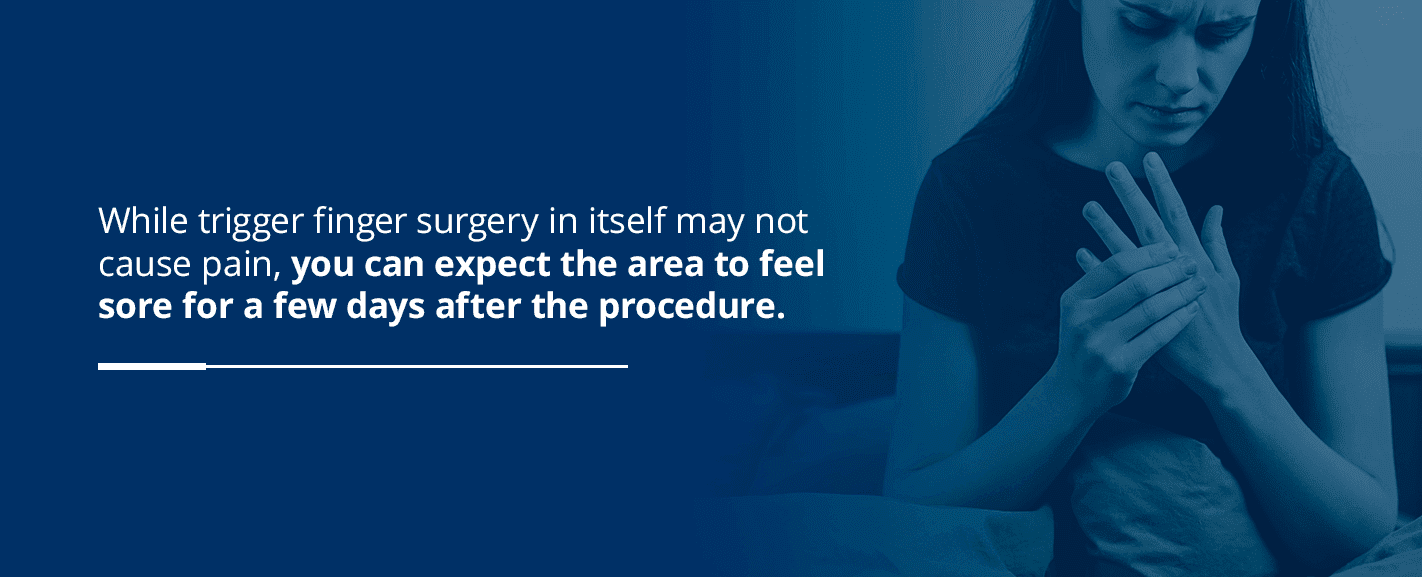
While trigger finger surgery in itself may not cause pain, you can expect the area to feel sore for a few days after the procedure. You might relieve pain by applying ice and taking over-the-counter pain medications. You should be able to move the affected finger immediately after surgery.
When Should You See a Doctor for Trigger Finger?
If you’re experiencing numbness, pain, stiffness or the inability to straighten or bend a finger, it’s best to visit your doctor. Your doctor can determine if you have trigger finger by performing a physical exam and reviewing your medical history. Once they figure out the cause of your symptoms, they can recommend a suitable treatment.
If any of your finger joints are hot and inflamed, or if you experience a sudden, severe onset of pain, get medical attention right away, as these are signs of an infection.
What Questions Should You Ask Your Doctor?
Trigger finger symptoms can make work, hobbies and other daily activities less enjoyable and more difficult. If you’re tired of trigger finger impacting your life, your doctor is waiting to help you. Before you visit your health care provider to figure out the cause of your discomfort, create a list of questions to ask so you can make the most of your appointment. You might ask the following:
- What is causing my pain and other symptoms?
- How long does this condition last?
- What are my treatment options?
- What treatments do you recommend?
- Will my circumstances get worse?
- Are there any complications I should be aware of?
Find Trigger Finger Treatment at OrthoBethesda
Trigger finger doesn’t always lead to pain and limited movement, but it’s debilitating in some cases. Whether you’re experiencing painful symptoms or are worried about changes you’ve noticed in your fingers or hands, doctors are ready to help you. It’s never too late to get treatment for trigger finger, even if the condition comes and goes for years.
At OrthoBethesda, our highly trained team of orthopedic surgeons specializes in treating joint, tendon and ligament injuries and conditions. As an innovative orthopedic care center with locations in Arlington, Virginia and Bethesda, Maryland, we’re ready to provide compassionate service and treat any issue related to the body’s musculoskeletal system. You deserve to feel good, regardless of your job, hobbies or other medical challenges you’re experiencing. To treat your trigger finger symptoms or learn more, please contact us today or schedule your appointment.

